World's Biggest Buildings
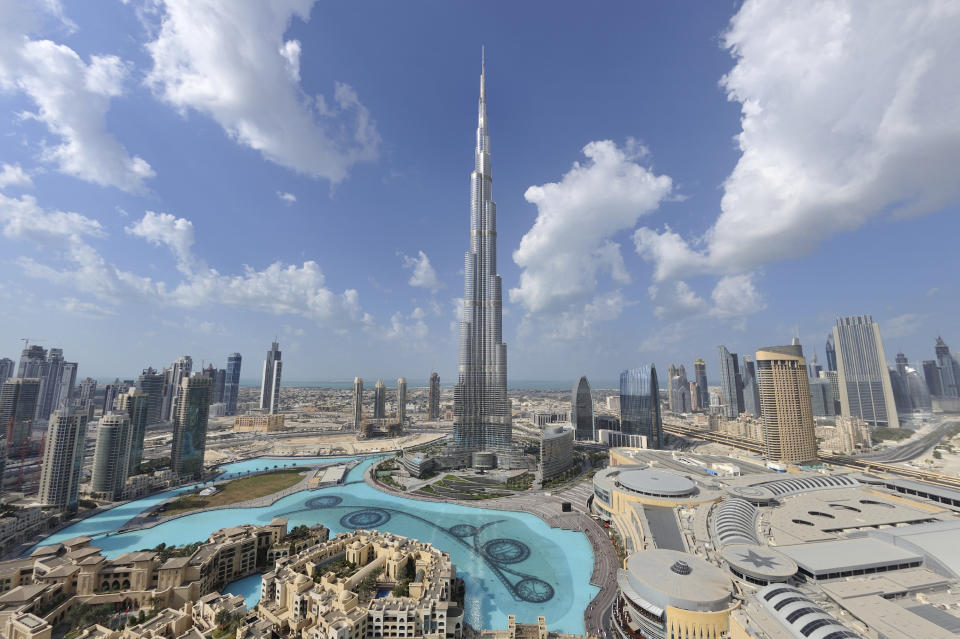
MORE FROM TRAVEL+LEISURE
The economy may be shrinking, but when it comes to architecture, big is in. Seems whenever there’s an economic downturn, buildings go to new heights. The Empire State Building went up in 1931 during the Depression. Similarly, Dubai'sBurj Khalifa topped out at 2,723 feet in 2010, deep into the Great Recession. When times are tough, nothing says stability like a big, solid structure—and these new buildings often become tourism icons.
Today’s superlatives of architecture trend toward high-tech achievements; even the concept of sustainable architecture is entering the record-setting race. The world’s largest solar building, designed to resemble a sundial, recently opened in Dezhou, China. Such cutting-edge buildings remind us that the impulse to think and build big isn’t a new one. Consider the Great Pyramids—the world’s tallest structures for nearly four millennia—or Beijing’s Forbidden City, which still holds the record for the world’s largest palace complex and lures 12.8 million annual visitors. Today, as architects strive to outdo each other, the new motto is evident: more is more.
Biggest Clock Tower:
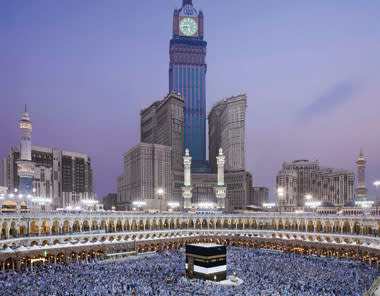
Abraj Al-Bait Clock Tower,
Mecca, Saudi Arabia
This mega–clock tower broke several world records when it opened in 2011. For now, at least, it’s the tallest clock tower in the world, the tallest hotel in the world (the Fairmont Makkah Clock Royal Tower), and the world’s largest clock face—visible from 16 miles away and topped by a golden crescent minaret whose massive loudspeakers emit prayer calls to a distance of four miles. If that weren’t enough, it’s also the world’s second-tallest building, exceeded only by Dubai’sBurj Khalifa. The mega-structure is adjacent to the world’s largest mosque, the Masjid al-Haram.
Biggest Solar Building:
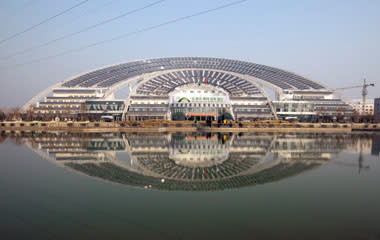
Solar City, Dezhou, China
Designed to resemble a sundial, the world’s largest solar building opened in 2009. Its 800,000 square feet of space is festooned with thousands of solar panels and features exhibit halls, scientific research facilities, and the 180-room International Solar Micro-Emission Hotel, which utilizes solar power and “will leave you impressive memory forever,” according to the website. The building is rumored to have used less than 1 percent of the steel used in Beijing’s Olympic Bird’s Nest.
Biggest Tent:

Khan Shatyr Tent,
Astana, Kazakhstan
The Khan Shatyr Entertainment Center (a.k.a. Royal Marquee), a giant transparent tent with a glass roof, was unveiled in 2006. The 500-foot-tall structure designed by Norman Foster’s firm remains the highest “tensile structure” in the world, while under its canopy is 10 football stadiums’ worth of landscaped park and shops, replete with squares, cobbled streets, a boating river, mini-golf courses, and a palm-lined beach filled with white sand from the Maldives.
Biggest Inverted Building:
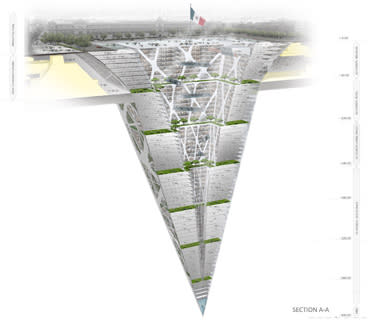
Earthscraper, Mexico City
A 65-story subterranean “Earthscraper” that would extend 900 feet under Mexico City’s El Zócalo and be covered in tempered glass sounds like an earthquake disaster waiting to happen. But the project’s designer, Esteban Suárez from architecture firm BNKR Arquitectura, promises a safe, ecofriendly structure that adheres to the city’s height restrictions, preserves historic Cuauhtémoc’s skyline, and prevents urban sprawl.
Biggest Archaeological Museum:
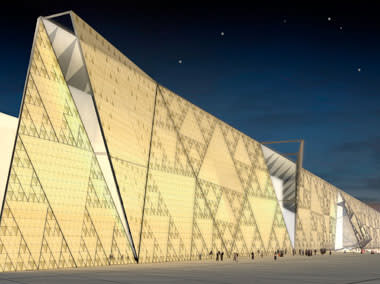
The Grand Egyptian Museum,
Giza, Egypt
Like many new extreme forms of architecture, Giza’s planned Grand Egyptian Museum was the outcome of a competition. The $550 million museum is slated to open in 2013 despite Egypt’s political turmoil. It’s a 210-acre project just a mile from the Giza Pyramids that will include a main structure made with translucent alabaster and a large atrium for ancient Egyptian artifacts and statues like the 3,200-year-old Ramesses II, relocated from Cairo’s Ramses Square.
Biggest Church:
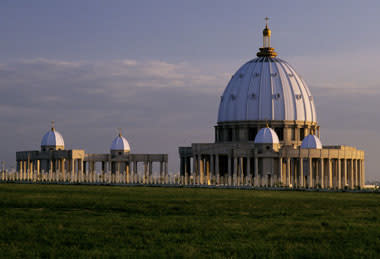
The Basilica of Our Lady of Peace,
Yamoussoukro, Ivory Coast
Africa gets a nod in the extreme architecture genre with the world’s largest Christian church, trumping even St. Peter’s in Vatican City. Built between 1985 and 1989 at a cost of $300 million, the nave has enough space to seat 7,000 people while offering standing room for an extra 11,000. Imported Italian marble and contemporary French stained glass adorn the basilica, which was commissioned by late Ivory Coast president Félix Houphouët-Boigny. His image can be seen as one of the Three Magi bearing gifts to Jesus in a stained-glass depiction of the Nativity.
Biggest Building:
Burj Khalifa, Dubai, UAE
The hymenocallis flower may have inspired the design team at Chicago’s Skidmore, Owings & Merrill, but the Burj Khalifa has an aggressive look, seeming to pierce the sky like a crystal weapon. The tower’s flashiest occupants are the 160-room Armani Hotel and an extra 144 Armani Residences (sold for more than $3,500 per square foot). It may not cling to its status as world’s tallest building for long; Mecca’s Kingdom Tower is scheduled to complete construction in 2016. If so, it would continue a recent trend of a skyscraper reaching a new height every six years.
Biggest Indoor Ski Resort:

Skipark 360°, Stockholm
A lack of high mountain peaks won’t stop Swedes from skiing close to home. C. F. Møller has begun designs for an architectural ski resort powered by geothermal, solar, wind, and hydropower, which when it opens in 2015 will make it the world’s biggest indoor ski resort—and the greenest. A 700-meter-long downhill slope and a drop of 525 feet meet the requirements for hosting the World Cup. The resort also includes a downhill run, a 3.5-kilometer cross-country skiing tunnel, a hockey and figure-skating rink, a snow park for snowboarding, and a spa.
Biggest Factory:

Boeing Everett Factory,
Everett, WA
Europe and the United States have become mostly bystanders in the race for record-breaking architecture, but America’s Boeing Everett Factory, 25 miles north of Seattle, remains the world’s largest building by volume and world’s largest factory. Workers assemble Boeing aircraft—including the new 787 Dreamliner—within this 472,000,000-cubic-foot factory. Ninety-minute public tours depart daily.
Biggest Single-Story Structure:
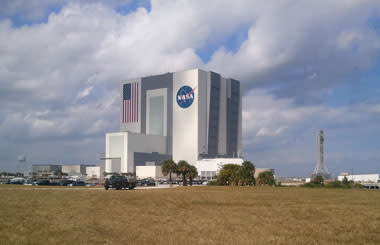
Vehicle Assembly Building,
Cape Canaveral, FL
Adorned with a massive American Flag and NASA Logo, the Kennedy Space Center’s behemoth eight-acre main building encompasses 129,428,000 cubic feet indoors. It is the world’s biggest single-story structure and the fourth largest by volume. Though the VAB retired in 2011, it helped launch 135 missions. It reopened for public tours in November 2011 after more than three decades off-limits; visitors on these new “Up-Close” tours get to view the launch pads where massive vehicles were assembled and walk along the Transfer Aisle, used to move elements of rockets among the building’s four High Bays.
See more of the World’s Biggest Buildings
